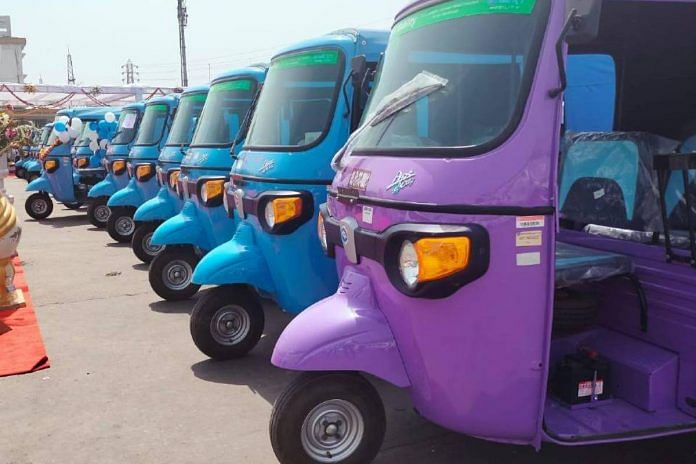New Delhi: To boost emission-free last-mile connectivity, the Delhi government for the first time has started giving out permits in bulk to set up ‘electric-auto-rickshaw footprint’ in specific localities to connect residences to metro stations in Delhi.
Currently, about 86 such e-vehicles are plying on the roads of Delhi, started under a joint venture between the Delhi government’s transport department and the Delhi Metro Rail Corporation (DMRC) on a public–private partnership (PPP) model.
“Earlier the permits used to be given to individuals but this time they have been given in bulk to the Delhi metro which in turn has partnered with private companies like Sun Mobility for setting up autorickshaw footprint in a defined geography and this experiment was started in Dwarka,” Delhi Transport Commissioner Ashish Kundra told ThePrint.
Kundra further explained how these e-autos were a novelty because they were running in accordance with the ‘hub and spoke model’, in which the ‘base station’ or the parking and battery-swapping facilities would be provided at the metro stations in Dwarka, Dwarka sector-21 and Janakpuri West. The e-three-wheelers, on the other hand, will be geo-fenced (use of location-aware device to install a virtual perimeter for a real-world geographic area) and allowed to move around only in close neighbourhoods.
The ‘hub and spoke’ paradigm refers to a distribution method in which a centralised ‘hub’ exists that organises routes as a series of ‘spokes’ that connect outlying points. In this case, the e-auto-rickshaws would not be allowed to move or provide services away from the predetermined areas.
The ‘experimental model’ was started in Dwarka last year with 50 e-autos by Sun Mobility and expanded to Azadpur area with 36 ev autos by ETO Motors and now the Delhi government is planning to scale it up by introducing it in areas like Rohini (another sub-city), Chhatarpur and NDMC (New Delhi Municipal Committee) areas.
Kundra said the plan was to target locations where people come from far away and need more connectivity options to go further in the city.
The Sun Mobility’s e-autos run on 6.3-kilowatt-hour capacity lithium-ion swappable batteries, with a range of 80-90 kms. The vehicle has a top speed of approximately 50 km per hour (kmph), according to the company executive.
The e-autos from ETO motors run on a 7.37 kilowatt-hour capacity lithium-ion battery, which charges within 3-4 hours and can run for 100 km on a single charge. The vehicle has a top speed of 45 kmph.
Also Read: ‘The road is mine and I am flying’—but men waiting for DTC women bus drivers to fail
Encouraging women drivers
According to the transport department and DMRC officials, since the e-autos were running on affordable shared fares for commuters at a nominal base price of Rs 10 for the first two km and Rs 5 for every subsequent km, it would be encouraging the mass adoption of e-three-wheelers in the capital city for the first time.
“The introduction of these e-autos will improve the last-mile connectivity for passengers of nearby localities. In recent years, DMRC has introduced many eco-friendly initiatives to ensure a robust last-mile connectivity system, which enables the commuters to prefer non-polluting public transport modes over personal vehicles,” said Anuj Dayal, Principal Executive Director, Corporate Communications, DMRC.
There has been a concentrated effort to employ more women drivers as well. Though in the PPP model, the responsibility of providing drivers is with the private players, the government is encouraging more women to join with more permits given/reserved for them than their male counterparts.
In Azadpur, for instance, ETO motors has trained and deployed only women drivers.
Other efforts
Apart from the DMRC’s fleet of smaller 100 electric buses that will soon be taken over by the Delhi government and operation of additional 380 feeder e-buses to strengthen and make the commute between residences/commercial hubs to metro stations easier, the transport department has also floated a tender for another 4,000 e-buses, half of which will be 9-metre long.
“Traditionally, 12 metre long buses run in the city but these new ones will be smaller and used as either ‘metro feeders’ or ‘rural feeders’. It will help in providing transportation where big buses can’t reach to pick up commuters from distant areas to the main bus or metro line in their localities,” Kundra explained.
Though e-autos and e-buses are currently being pushed by the government, the latter has been found unviable as it is under-utilised and run under capacity. The e-autos are found to be much more suited to e-buses for last-mile connectivity, while the latter works best for transport within the city.
According to officials, the e-autos were also much safer than e-rickshaws that were originally conceptualised for last-mile connectivity, but not anymore because they were neither fit for main roads nor meant to ply on it as it obstructed traffic.
Edited by Geethalakshmi Ramanathan
Also Read: Why are Delhi, Mumbai people fighting over city pride? You’re not Batman from Gotham



